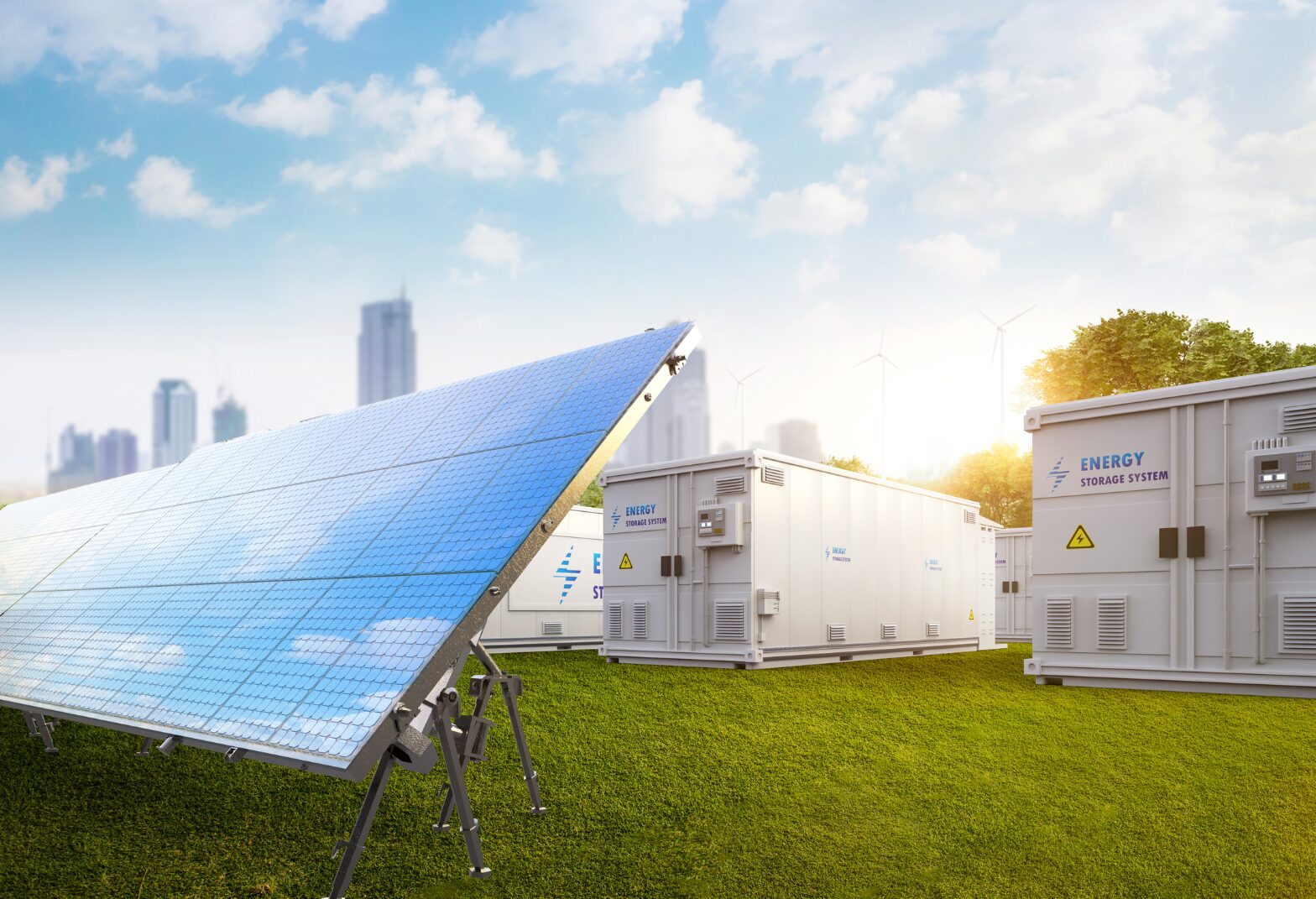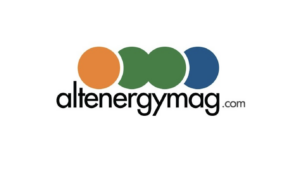
Energy storage systems are technologies that store energy from the electrical grid for later use. These systems can take various forms, including batteries, pumped hydro, flywheels, and thermal storage. Among the types of battery storage technology, lithium-ion batteries are common.
Renewable energy sources like solar and wind are intermittent by nature. Solar panels generate electricity only during daylight hours, and their output can vary with cloud cover. Similarly, wind turbine generation depends on weather conditions.
Battery energy storage systems, or BESS, are crucial pieces of renewable energy systems because they can store excess energy generated during peak production times and release it later when demand is high and generation assets are at maximum capacity. This facilitates a steadier clean energy supply and enhances the stability and reliability of the power grid.
As the demand for clean energy continues to rise, energy storage systems will be key to ensuring that renewable sources can meet this demand consistently and effectively. A number of financing mechanisms have been developed to accelerate their adoption – in particular, tax credits. This guide unpacks the tax credits for battery storage included in the US Inflation Reduction Act (IRA).
What is the Inflation Reduction Act (IRA) Credit for Battery Storage?
The Inflation Reduction Act (IRA) of 2022 marked a significant step forward for the United States in its efforts to combat climate change and promote clean energy. Among the many provisions of the IRA, the introduction of battery storage system tax credits stands out as a major incentive for individuals and businesses looking to invest in energy storage solutions.
These battery storage system tax credits aim to accelerate the adoption of energy storage technologies. By providing substantial financial incentives, the IRA not only makes energy storage more economically viable but also underscores the critical role that these systems play in transitioning to a more sustainable energy future.
Solar and Storage Projects Under the IRA
Historically, there were only federal tax credits for solar battery storage. This meant that battery storage systems installed independently or added to existing solar systems did not qualify for these incentives.
The IRA has changed this by allowing standalone projects to qualify for federal tax incentives for battery storage systems, making it easier and more financially attractive to invest in these storage systems without needing to pair them with new solar installations.
Investment Tax Credit (ITC) for Solar Panels
The ITC is a crucial incentive that has supported the growth of solar energy in the United States. It provides a percentage-based tax credit for solar battery storage systems. Under the IRA, the ITC has been extended and enhanced, ensuring continued support for solar energy projects.
Transferability of Tax Credits under the IRA
The IRA simplifies investment in clean energy projects by introducing the transferability of tax credits. This provision significantly enhances the flexibility and attractiveness of these investments.
Previously, the benefits of tax credits were limited to the entities directly investing in or developing clean energy projects. These entities needed sufficient tax liability to utilize the credits fully, which often limited participation to larger, profitable companies. The IRA allows clean energy tax credits to be transferred or sold to third parties. This means that if a project developer cannot use the full value of the tax credits, they can sell them to another entity that can. This flexibility simplifies financing structures and makes it easier for a broader range of investors to participate in clean energy projects.
By creating a secondary market for tax credits, the IRA increases the liquidity of these financial instruments, making clean energy investments more attractive and reducing the cost of capital. Knowing that tax credits can be sold provides developers with greater financial certainty and stability, encouraging more projects to move forward from planning to implementation.
What is the Battery Storage Tax Credit for 2024?
The IRA includes several provisions aimed at incentivizing Americans to adopt energy storage systems through tax credits. These battery storage technology tax credits are available to both residential and commercial entities, to facilitate a wider spread of clean energy development.
1. Residential
Homeowners can take advantage of the Residential Clean Energy Credit, which provides a tax credit for battery storage systems with a capacity of at least 3 kilowatt-hours (kWh). This credit covers 30% of the associated cost, including installation expenses. The credit is available for systems installed between 2023 and 2032, gradually decreasing after 2032. As part of the effort to reach clean energy goals, some states and utility organizatons also offer incentives for adopting clean energy solutions. So not only will the IRA provide tax credits for clean energy installs, but more money can then be saved through these initiatives.
2. Commercial/Grid-scale
There is also a investment tax credit for larger energy storage projects. The Section 48 Investment Tax Credit offers businesses a similar 30% base tax credit for energy storage systems under 1 MW, or over 1 MW if certain apprenticeship and wage requirements are met. At this level additional adders are also available for using domestic content and siting the project in an energy community, to boost the tax credit up to 70%. The ITC is available for systems placed in service before or on January 1, 2025. After that date the Clean Electricity Production Tax Credit and the Clean Electricity Investment Tax Credit will replace the traditional PTC / ITC.
By lowering the upfront costs, this credit encourages businesses to integrate energy storage into their asset portfolio, promoting a more resilient and sustainable energy infrastructure.
Do Storage Batteries Qualify for Solar Tax Credits?
Yes, standalone battery storage now qualifies for the 30% Residential Clean Energy Credit, introduced in 2023 under the IRA.
This significant change means homeowners can receive a 30% tax credit for the installation of battery storage systems, even if they are not paired with new solar panels. The inclusion of standalone battery storage under this credit greatly enhances the financial viability and attractiveness of investing in these systems.
Benefits of Battery Storage for Home Energy
Purchasing and installing a solar and storage system offers homeowners a range of benefits:
- Backup Power: Provides a reliable source of electricity during power outages, ensuring continuity for essential appliances and systems in your home.
- Taking Advantage of Time-of-Use (ToU) Rates: Allows homeowners to store energy when rates are low and use it during peak times when electricity costs are higher, resulting in significant savings on energy bills.
- Increasing Consumption of Solar Energy: Enhances the efficiency and utility of solar panels by storing excess energy generated during the day for use at night or on cloudy days, maximizing the use of renewable energy and reducing reliance on the grid.
Do Lithium Batteries Qualify for Tax Credits?
Yes, lithium batteries do qualify for the tax credit under the Inflation Reduction Act (IRA), with the potential for additional federal tax incentives for battery storage systems that can increase the credit up to 40%. Lithium batteries are eligible for the 30% Residential Clean Energy Credit, with an additional 10% tax credit if the energy storage system meets specific domestic content requirements.
To qualify for this add-on, the system must adhere to guidelines ensuring that materials and manufacturing processes are sourced in the United States. Systems that incorporate lithium batteries or other components manufactured outside of the United States are unlikely to qualify.
Benefits of the IRA
The federal tax credits for battery storage introduced in the IRA represent a significant opportunity for homeowners and businesses to invest in clean energy technologies. By reducing the upfront costs of energy storage systems, these tax credits make it more affordable to enhance energy security, improve grid stability, and reduce environmental impact.
As more Americans adopt energy storage, the United States will be better positioned to achieve its renewable energy goals and build a more sustainable future. From homeowners looking to reduce energy bills to businesses aiming to enhance operational resilience, now is the time to explore the benefits of battery storage for home energy and take advantage of these valuable tax incentives.
The IRA allows Americans to enjoy financial savings and energy security, in a crucial step toward a cleaner, more sustainable energy landscape for future generations.
Learn more about Alsym Energy’s high-performance, non-flammable battery solutions




